Nymphalidae
| Nymphalidae | ||||||||||||||
|---|---|---|---|---|---|---|---|---|---|---|---|---|---|---|
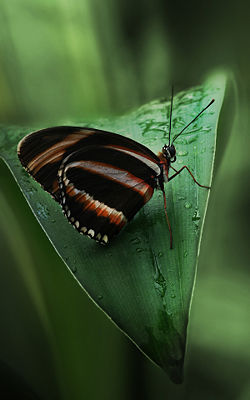 Dryadula phaetusa
|
||||||||||||||
| Scientific classification | ||||||||||||||
|
||||||||||||||
| Diversity | ||||||||||||||
| Over 600 genera About 5,700 species |
||||||||||||||
| Subfamilies | ||||||||||||||
and see article text |
The Nymphalidae is a family of about 5,000 species of butterflies which are distributed throughout most of the world. These are usually medium sized to large butterflies. Many species are brightly colored and they include popular species such as the emperor, admirals, tortoiseshells and fritillaries. However, the underwings are dull and in some species look remarkably like dead leaves, or are much paler, producing a cryptic effect that helps the butterfly disappear into its surroundings.
Contents |
Classification
In adult butterflies, the first pair of legs are small or reduced, giving the family the other names of four-footed or brush-footed butterflies. The caterpillars are hairy or spiky with projections on the head, and the chrysalids have shiny spots.
The forewing has the submedial vein (vein 1) unbranched and in one subfamily forked near base; medial vein with three branches, veins 2, 3 and 4; veins 5 and 6 arising from the points of junction of the discocellulars; subcostal vein and its continuation beyond apex of cell, vein 7, with never more than four branches, veins 8-11 ; 8 and 9 always arising from vein 7, 10 and also 11 sometimes from vein 7 but more often free, i.e. given off by the subcostal vein before apex of cell.[1]
The hindwing has internal (1a) and precostal veins. The cell in both wings closed or open, often closed in the fore, open in the hind wing. Dorsal margin of hind wing channelled to receive the abdomen in many of the forms.[1]
Antennae always with two grooves on the underside; club variable in shape. Throughout the family the front pair of legs in the male, and with three exceptions (Libythea, Pseudergolis and Calinaga) in the female also, is reduced in size and functionally impotent; in some the atrophy of the fore legs is considerable, e.g. Danainae and Satyrinae In many of the forms of these subfamilies the fore legs are kept pressed against the underside of the thorax, and are in the male often very inconspicuous.[1]
Systematics and phylogeny
The phylogeny of the Nymphalidae is complex. Several taxa are of unclear position, reflecting the fact that some subfamilies were formerly well-recognized as distinct families due to insufficient study.
There are five main clades within the family:[2]
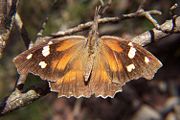
The libytheine clade (basal)
- Libytheinae (Snout butterflies. Earlier treated as distinct family Libytheidae.)
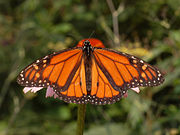
The danaine clade (basal)
- Danainae (Milkweed butterflies. Earlier treated as distinct family Danaidae.)
- Host plant families include Apocynaceae, Asclepidaceae, and Moraceae.
- Ithomiini (About 300 Neotropical species. Sometimes considered a subfamily Ithomiinae.)
- Most species with long wings, some having transparent wings. Host plants in the families Apocynaceae, Gesneriaceae and Solanaceae.
- Tellervini (About 6–10 species in Australasia. Sometimes considered a subfamily Tellervinae.)
- Caterpillars resemble those of the Danainae and feed on Apocynaceae.
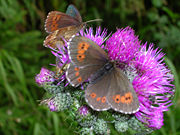
The satyrine clade
- Calinaginae (About 6 species, restricted to the Himalayas.)
- Mimics of the Danainae and restricted to host plants in the family Moraceae.[3]
- Charaxinae
- Tropical canopy butterflies. Caterpillars often with head spines or projections. Mostly edible species with some Batesian mimics. Host plants in the families Annonaceae, Celastraceae, Convolvulaceae, Euphorbiaceae, Fabaceae, Flacourtiaceae, Lauraceae, Myrtaceae, Piperaceae, Poaceae, Rhamnaceae, Rutaceae, Santalaceae and Sapindaceae.[3]
- Morphinae (including Amathusiini, sometimes considered a subfamily Amathusiinae.)
- Include the spectacular neotropical Morphos. Food plants include the Arecaceae, Bignoniaceae, Fabaceae, Menispermaceae, Poaceae and Sapindaceae.
- Brassolini (Owls. Neotropical with 70–80 species. Mostly crepuscular. Sometimes considered a subfamily Brassolinae.)
- Host plants in the families Arecaceae, Bromeliaceae, Heliconiaceae, Musaceae, and Poaceae.[3]
- Satyrinae (Satyrs and Browns. Earlier treated as distinct family Satyridae.)
- Host plants in the families Arecaceae, Araceae, Cyperaceae, Heliconiaceae, Poaceae, and Selaginellaceae.
The heliconiine clade (sister group of the nymphaline clade; excludes former tribes Biblidini and Cyrestini, and tribes Pseudergolini and Coeini.)
- Heliconiinae (Earlier treated as distinct family Heliconiidae.)
- Colourful tropical butterflies noted for Müllerian mimicry. All species use host plants in the family Passifloraceae.
- Acraeini (Mostly African, but some species in Asia. Sometimes considered a family Acraeinae.)
- Host plant in the families Asteraceae, Passifloraceae, Sterculiaceae, Tiliaceae and Urticaceae.
- Limenitidinae
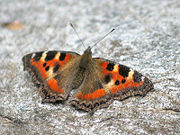
The nymphaline clade (sister group of the heliconiine clade; also includes tribes Coeini and Pseudergolini)
- Apaturinae (Mostly tropical)
- Host plants in the family Ulmaceae. Caterpillars smooth with bifid tails and horns on the head.[3]
- Biblidinae (formerly in Limenitidinae)
- Cyrestinae (formerly in Limenitidinae)
- Nymphalinae (A large subfamily that sometimes includes the Limenitidinae and Biblidinae.)
- Some species migratory. Caterpillars sometimes covered in spines. Host plants include Acanthaceae, Caprifoliaceae, Convolvulaceae, Euphorbiaceae, Fagaceae, Flacourtiaceae, Lamiaceae, Loranthaceae, Moraceae, Plantaginaceae, Poaceae, Rubiaceae, Rutaceae, Salicaceae, Sapindaceae, Scrophulariaceae, Urticaceae and Verbenaceae.[3]
Example species from this family
- Archdukes, genus Lexias
- California tortoiseshell, Nymphalis californica
- Comma, Polygonia c-album
- Common buckeye, Junonia coenia
- Common Snout Butterfly, Libytheana carinenta
- Cracker butterflies, genus Hamadryas
- Crimson Patch, Chlosyne janais
- Lorquin's Admiral, Limenitis lorquini
- Marsh Fritillary, Euphydryas aurinia
- Meadow Brown, Maniola jurtina
- Mourning cloak, Nymphalis antiopa
- Monarch butterfly, Danaus plexipus
- Blue Morpho, Morpho menelaus
- Painted Lady, Vanessa cardui
- Peacock, Inachis io
- Question Mark, Polygonia interrogationis
- Red Admiral, Vanessa atalanta
- Small Heath, Coenonympha pamphilus
- Small Tortoiseshell, Nymphalis urticae
Footnotes
References
- Bingham, C.T. (1905): Fauna of British India. Butterflies. Vol. 1.
- DeVries, P.J. (2001): [Nymphalidae]. In: Levin, S.A.: Encyclopedia of Biodiversity. Academic Press.
- Wahlberg, Niklas; Weingartner, Elisabet & Nylin, Sören (2003): Towards a better understanding of the higher systematics of Nymphalidae (Lepidoptera: Papilionoidea). Molecular Phylogenetics and Evolution 28: 473–484. doi:10.1016/S1055-7903(03)00052-6 PDF fulltext
External links
- Butterflies of North America: Nymphalidae thumbnail images and species list. United States Geological Survey Northern Prairie Wildlife Research Center.
- Canadian Biodiversity Information Facility (2003): Family Nymphalidae
- Nymphalidae Systematics Group at Turku University
- Peter Chew: Danaids and Browns - Family Nymphalidae, Brisbane butterflies web site (2005).
- Tree of Life Web Project: Nymphalidae
- Nymphalidae from all over the world
on the UF / IFAS Featured Creatures Web site
- Agraulis vanillae, Gulf fritillary
- Anaea andria, goatweed butterfly
- Eunica monima, dingy purplewing
- Heliconius charitonia, zebra longwing
- Phyciodes phaon, phaon crescent
|
|||||||||||||||||||||||||||||||